"Emka": the history of the service car officer (part 2)
Despite the fact that the emka turned out to be much better than its American prototype, it was adapted for use in Russian conditions, its off-road qualities left much to be desired. Simply put, the M-1’s permeability was not up to par: front-line drivers remember well how much power they had to put on spring and autumn slush to get the emka stuck in an impassable ridge. And with what sincere envy they were escorting exactly the same in appearance of the car, who jokingly coped with the muddy road - all-terrain vehicles M-61-73! ..
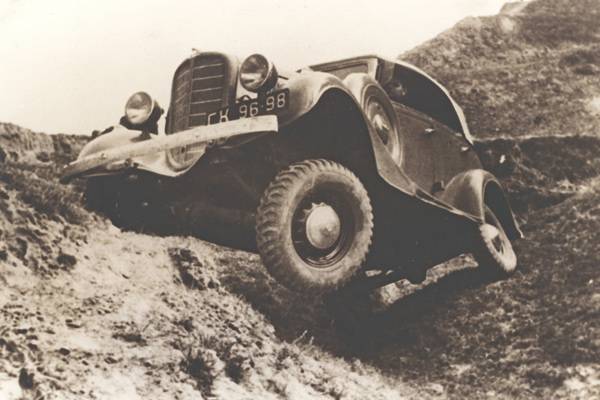
The all-terrain vehicle M-61-40 is on trial. Photo from snob.ru
The fact that the army car lacks permeability, the military began to speak almost immediately. The classic "emka" perfectly coped with the tasks of the staff car, when you did not have to go into serious off-road. But professional military men differ from all others in that they are obliged to think first of all about how and with what they will have to fight. And from this point of view it was clear: the ordinary M-1 cannot be considered an all-terrain vehicle, even with a very big stretch.
On this basis, by the summer of 1938, the command of the Red Army formulated a request for a passenger car-all-terrain vehicle based on the EMKI. Why the base chose this particular car is understandable: by this time the troops had gained enough experience in operating and maintaining the M-1 machines, the technical companies had an adequate supply of spare parts, and therefore it did not make sense to make a garden, creating an all-terrain vehicle on a new base and creating unnecessary difficulties for the military. At the end of July 1938, the design specification for the design of a comfortable all-wheel drive vehicle-all-terrain vehicle arrived at the plant, and the development team led by Vitaly Grachev (the future designer of the legendary GAZ-64 and GAZ-67B gas engines) began work.

The most common version of the "emki" all-terrain vehicle - the car M-61-73. Photo from the site http://ursa-tm.ru
First of all, they chose a modification of the emka, which could be taken as a basis. It was impossible to use the familiar 1 model on the M-1936 conveyor of the year model, which was well known to designers: its engine was too weak for an all-terrain vehicle. But by that time, GAZ had already begun work on a new engine - reincarnation (since the total amount of innovations and improvements was quite large) of the six-cylinder Dodge D5 engine, which received the national GAZ-11 index. It was he who became the heart of the future SUV based on the "emka".
Since the work on fulfilling the order of the military was in parallel with the modernization of the basic model M-1, it was decided to unify the new product with the modernized emka for the body and many other details, but with a completely different suspension and all-wheel drive. This was the most difficult task for designers: they had to quickly develop a driving front axle for the car and a transfer case, that is, to do something that in our country industrial, and not experimental scales, nobody did to them.
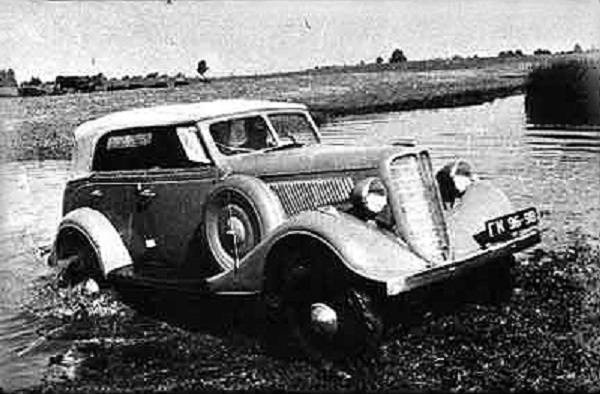
M-61-40 with a phaeton body overcomes the ford. Photo from www.autowp.ru
Nevertheless, the experimental design bureau of Vitaly Grachev coped with this successfully. Moreover, in the course of development, the designer had to solve an almost detective task: to unravel the secret of creating pivot hinges for the swivel wheels of the front drive axle: until then, in our country no one had developed and produced such nodes. It was not possible to buy a license for their production: manufacturers refused to the Soviet automobile plant. It was necessary to go for a trick: to purchase the model LD2, created by Marmon Herrington, which was engaged in tuning ordinary cars to off-road vehicles, based on the well-known Ford GAZ car with the V8 engine. Having received the pivots of this car, Grachev eventually figured out the principles and geometry of the hinge grooves - and developed his own king pin for the first domestic SUV.
By January 1939, the working drawings were ready, and the 10 of June of the same year, the first car - still experienced, not serial, was assembled and submitted for testing. The exam for the first GAZ SUV was to be harsh. He needed to be tested for durability and throughput in the most difficult conditions to make sure that the car was really able to drive where everyone else was saved. But Grachevskaya novelty coped with this!
Tests have shown that the all-terrain vehicle, which received the GAZ-61 index, has outstanding off-road qualities for its time and class. He could lift on hard ground up to 28 degrees, on sand - up to 15 degrees from the spot and up to 30 degrees from the course, with the fan belt removed, overcame a ford 82 centimeter deep, took 90-centimeter ditches and walked confidently along a forty-centimeter snow cover (this It turned out a little later, when the weather conditions allowed). With a full half-ton load, the car accelerated on the highway to 108 kilometers per hour, and on sand to 40 kilometers per hour. It is noteworthy that during the tests, the all-terrain vehicle was forced to climb the famous “Chkalov ladder” leading from the Volga embankment to the Nizhny Novgorod Kremlin. The car went up steadily, breaking 273 stone steps, and not in a straight line, but with turns - and proved its excellent off-road abilities. Thus was born the first in the world closed, comfortable SUV.
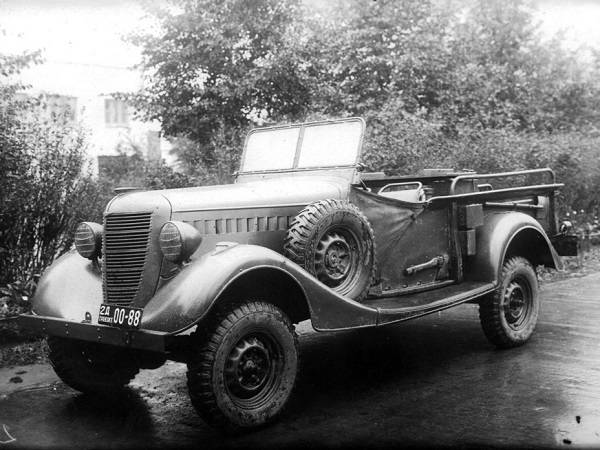
Modification of M-61-416 in the courtyard of the Gorky Automobile Plant. Photo from http://warspot.ru
By the end of 1940, by order of the People’s Commissariat of Heavy Industry, GAZ-61, in the sedan version with a closed metal body, received the 73 index, and in the “phaeton” version with the open one, GAZ-61-40 was launched. Since on the conveyor it was a much more complex machine than the non-wheel-drive M-11 (the same emka, but with the same new engine GAZ-11), it was decided to release the all-terrain vehicle in small batches for the higher command personnel. That is why GAZ-61-73 and -40 got the nickname “all-terrain vehicle for marshals”: the most famous of its passengers were Georgy Zhukov (who, according to his chauffeur Alexander Buchila, preferred all such cars), Ivan Konev, Semyon Budyonny, Konstantin Rokossovsky and Semyon Timoshenko. In total, it was planned to release 500 all-terrain vehicles of both versions, but the war corrected these plans, and all 200 of such cars came off the conveyor: 194 in the 73 variant and six in the 40 variant.
"Emka" -protivotankist
Assessing the high off-road qualities of the new car, the designers of GAZ, perfectly feeling that the air smells more and more distinctly of war, thought about creating a light artillery tractor on its basis. Until then, the main force in artillery, especially small-caliber and anti-tank, were horses - but it was clear that they needed to be replaced with a car as soon as possible.
The idea of gazovtsev was simple and logical: to connect the possibility of GAZ-61 with the appearance of the newly developed pickup GAZ-M-415, produced on the basis of the classic M-1 and well-developed. It turned out a sane machine that possessed only one unsuccessful feature for an army vehicle: with the closed cabin inherited from the "four hundred and fifteenth" and complex in form, it was unsuitable for fast and cheap production in wartime.
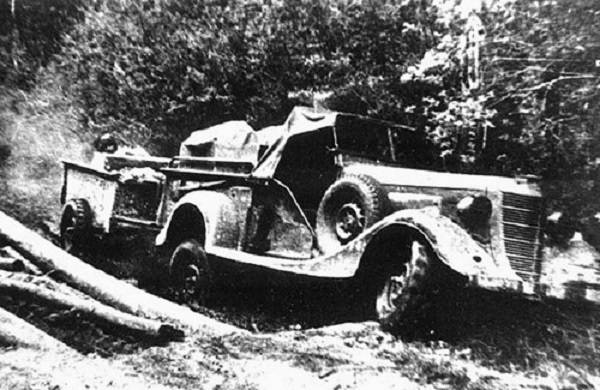
An experimental copy of the M-61-416 on trial. Behind attached a shell front, which was abandoned in the series. Photo from http://www.nika-limuzin.ru
It was necessary to find a way to simplify and reduce the cost of construction - and it was found. The designers of GAZ refused the closed cabin and then the doors. As a result, the car received the exterior of a classic army off-roader of the Second World War, which is well known from front-line photographs: an open cab with a canvas awning, instead of doors — openings with tarpaulins, a rectangular body with longitudinal benches behind, representing a shell box in which 15 shells were packed three canisters. In short, nothing complicated and superfluous, absolute practicality and lightness.
It was in such a simplified form that the first pickup GAZ-61-416 was assembled on the fourth day of the war - June 25 of the year 1941. The second copy was assembled for August 5, and in October, the 1941-th began the serial production of these machines. The simplified body was immediately adapted for artillery needs: shell boxes and other ammunition were placed under the longitudinal benches, and a trailer hitch, for which the gun was hooked, was placed at the back (it was possible to refuse from the shell front, connecting the benches and the shell box). Spare wheels were installed in the front fenders: they not only provided quick replacement if necessary, but also served as additional anti-bullet protection for the engine.
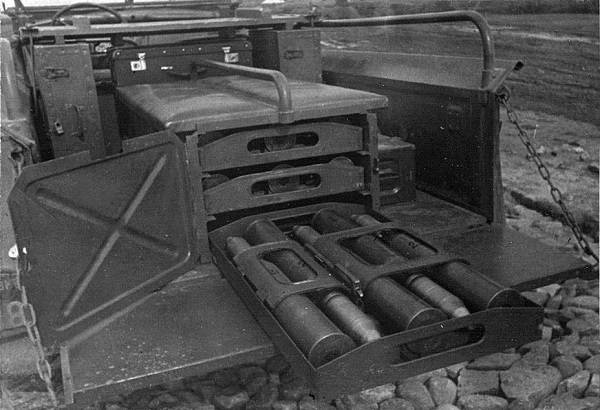
Reference sample car M-61-416. The shell box is clearly visible, at the same time being a seat for calculating the ZIS-2 gun. Photo from http://warspot.ru
Since the Gorky plant No. 92 located near GAZ by that time had already launched the production of one of the most successful anti-tank guns of the Second World War - the 57 mm ZiS-2 gun designed by the famous Vasily Grabin, there were no questions about what the GAZ-61 would be a tractor for -416. The first 36 (according to other sources - 37) vehicles assembled by the Gorky residents during 1941, received regular guns immediately upon leaving the factory - and headed towards Moscow, where they almost immediately went into battle. Alas, the first cars became the last: by the beginning of 1942, due to the loss of a significant part of metallurgical plants in the western part of the USSR, there was a shortage of automobile steel sheet, and the production of the all-terrain vehicle-tractor was stopped. Later, in June 1942, the Red Army command, which assessed the capabilities of the light anti-tank complex as part of the ZiS-2-GAZ-61-416, issued an order to resume production of a successful car, but this was no longer technically possible. By that time, all the GAZ-11 engines that were available went to the production of light tanks T-60 and T-70: for the sake of this, they were even removed from the M-11 modifications taken from civilian users.
From cars to armored cars
After the start of World War II, the vast majority of M-1 vehicles of all modifications turned out to be in the army. Machines that were in civilian use literally “called for” military service, compensating for the catastrophic losses of the first months of hostilities. In the case were all the options: and pickups, and phaetons, and of course, the most common closed model "emka". But there was another car that, with some stretch, can also be considered a modification of the GAZ-M-1 - the BA-20 lightweight armored car. This is what can be called the most military of all the variants in which the emka was issued!
Designing a new armored car, which was supposed to replace the FAI armored car that was in service with the 1933 of the year. The reason was simple: the base for the FAI was a GAZ-A passenger car, the production of which was rolled up for the sake of emoc. Accordingly, it was necessary to create an armored car on a new base - and it is completely logical that GAZ-M-1 became this base.
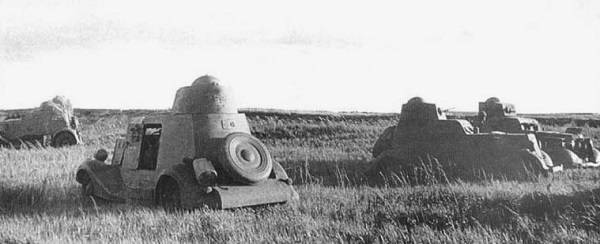
Armored BA-20 on maneuvers. Photo from http://bronetehnika.narod.ru
The design of an armored car based on it went almost in parallel with the preparation of the M-1 for placing on the conveyor. The result was that the BA-20 almost overtook the mother platform in serial production. The standardized version of the new armored car was prepared and handed over for testing in February 1936 of the year, and in July, when the emki began to roll off the conveyor in full swing, technical documentation was transferred to the Vyksa crushing and grinding equipment plant. Despite the strange name, it was precisely this enterprise located under Gorky that the BA-20 had to be adjusted.
In 1937, the BA-20 received a new conical tower, which became its main one, and a year later, the modernized model BA-20M appeared, which was distinguished not only by reinforced springs and rear axle, but also by thicker armor of the forehead and tower, as well as a new radio station which received a whip antenna instead of a handrail, which equipped the machines of earlier releases. Together with the new radio, a third fighter appeared in the crew - a radio operator who served it. They also reinforced the armored vehicle’s armament: in addition to the main DT machine gun mounted in the turret, another one of the same spare was now in the fighting compartment. True, they did not increase their ammunition: as before, it was still 1386 cartridges - 22 disc magazines.
A new armored car in the same 1936 year received another modification, rather unusual - BA-20ж / д. The additional alphabetic index was deciphered traditionally - “railway”. Such an armored car had, in addition to the usual wheels, four more replaceable metal ones equipped with a flange - a rim, the same as that of the carriage wheels, and could move on them along a railway track. For half an hour by the forces of the crew, the armored car turned into armored rubber, capable of passing from 430 to 540 km by rail. In this case, if necessary, for the same half hour, the armored rubber was converted back into an armored car: the removed automobile wheels were fastened along the sides.
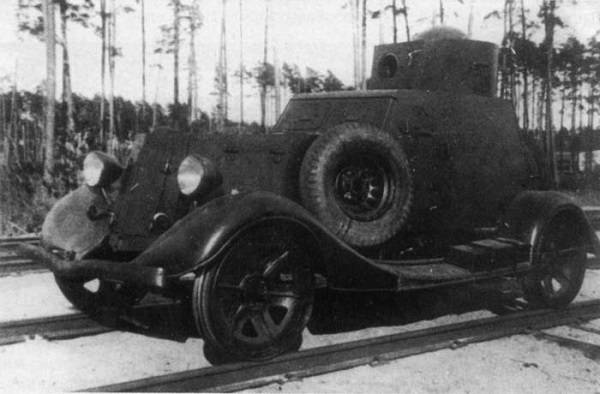
Armored vehicle BA-20 in the rail version, mounted on rails. Photo from http://bronetehnika.narod.ru
BA-20 was so successful and easy to manufacture and maintain the machine that became the most massive armored car of the Red Army. In total, 1936 through 1942 year released 2013 (according to other data - 2108), of which 1557 collected before the start of World War II. This machine took part in all armed conflicts, wars and campaigns, starting with 1936: it passed the Khalkhin Gol and the Winter War with Finland, entered the Western Ukraine and Bessarabia during the Liberation March, and fought from the first to the last day of the Great Patriotic War , having even noted in the war with Japan in the late summer and early autumn 1945.
The crown of officer's career
Taxi, pickup, staff car, journalistic car, “all-terrain vehicle for marshals”, artillery tractor-SUV, armored car - in what guises did not appear the legendary emka! It is rightfully the first mass passenger car of the Soviet Union: the total production of all modifications of this car was almost 80 000 copies. And the overwhelming majority of them somehow took part in the Great Patriotic War - and many did not return from it.
“We have a reason to drink: for military wire, for Y-2, for emku, for success! ..”, - these words from the once popular Song of War Correspondents by Konstantin Simonov best describe the attitude towards M-1 on the war and after it. This legendary car has served what is called "from bell to bell" by entering history domestic automotive industry not only as the first Soviet car mass production, but also as a car-warrior. If the lorry produced by the same GAZ truck - a GAZ-AA truck - was called a soldier vehicle, then the emku can be rightfully called an officer vehicle. An officer who traveled from lieutenant to marshal - and passed him more than worthily.
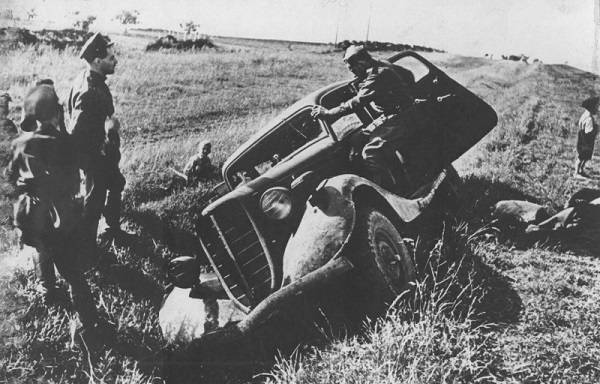
War correspondent Konstantin Simonov (second from left, in profile) on the Kursk Bulge near the GAZ-M-1, which slid into a ditch. Photo from http://waralbum.ru
Sources:
https://ru.wikipedia.org
https://www.zr.ru
http://techno-story.ru
http://www.nika-limuzin.ru
http://wio.ru
http://armedman.ru
http://www.abs-magazine.ru
https://www.autowp.ru
http://avtomobilgaz.ru
http://www.birzhaplus.ru
http://bronetehnika.narod.ru
Information